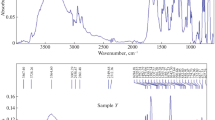Abstract
The self-assembly pattern of functionalized chitosan (CS), in various solvent mixtures, was discussed here. The previously synthesized amphiphilic thiobarbiturate-derived chitosan (CS-TBA) molecule (where the chitosan backbone was relatively more hydrophobic and the thiobarbiturate moiety was relatively more hydrophilic) was subjected to different solvent mixtures for this purpose. Then the morphological changes of the aggregates were studied and analyzed from the perspective of size and shape through various conventional techniques. One of the components of the solvent mixture was water, whereas another component was a different polar protic solvent i.e.; methanol and polar aprotic solvents such as tetrahydrofuran, acetonitrile and dioxane. The superstructures were characterized using field emission scanning electron microscope (FESEM), transmission electron microscope (TEM), cryo transmission electron microscope (cryo-TEM) and differential light scattering (DLS) methodologies. Finally, the usability of the solvent-dependent morphologies was deliberated in this article. Through the detailed spectroscopic analysis, we observed various unique and magnificent morphologies in terms of size and shapes in different solvent mixtures (protic as well as aprotic and different in terms of polarity index). The astonishing superstructures also have fascinating dye encapsulation abilities (above 80% encapsulation for hydrophobic as well as a hydrophilic dye in case of methanol/water solvent mixture) in different solvent mixtures which could be applied in the field of self-assembly and dye removal industries.









Similar content being viewed by others
References
Yang Y, Wang S, Wang Y, Wang X, Wang Q, Chen M (2014) Advances in self-assembled chitosan nanomaterials for drug delivery. Biotechnol Adv. https://doi.org/10.1016/j.biotechadv.2014.07.007
Liang H, Sun X, Gao J, Zhou B (2020) Conducting chitosan/hydroxylethyl cellulose/polyaniline bionanocomposites hydrogel based on graphene oxide doped with Ag-NPs. Int J Biol Macromol. https://doi.org/10.1016/j.ijbiomac.2020.10.097
Hu Y, Du Y, Yang J, Tang Y, Li J, Wang X (2007) Self-aggregation and antibacterial activity of N-acylated chitosan. Polymer. https://doi.org/10.1016/j.polymer.2007.03.063
Wang J, Zhuang S (2022) Chitosan-based materials: Preparation, modification and application. J Clean Prod. https://doi.org/10.1016/j.jclepro.2022.131825
Deb J, Das M, Das A (2017) Excellency of natural polymer in drug delivery system: A Review. Int J Pharm Biol Sci Arch. http://ijpba.in/index.php/ijpba/article/view/64
Kale TS, Klaikherd A, Popere B, Thayumanavan S (2009) Supramolecular assemblies of amphiphilic homopolymers. Langmuir. https://doi.org/10.1021/la900734d
Dang JM, Leong KW (2006) Natural polymers for gene delivery and tissue engineering. Adv Drug Deliv Rev. https://doi.org/10.1016/j.addr.2006.03.001
Akash MSH, Rehman K, Chen S (2015) Natural and synthetic polymers as drug carriers for delivery of therapeutic proteins. Polym Rev. https://doi.org/10.1080/15583724.2014.995806
Sailaja AK, Amareshwar P, Chakravarty P (2011) Chitosan nanoparticles as a drug delivery system. Int J Pharm Pharm Sciences ISSN:0975–1491
Mane S, Rao VN, Shunmugam R (2012) Reversible ph- and lipid-sensitive vesicles from amphiphilic norbornene-derived thiobarbiturate homopolymers. ACS Macro Lett. https://doi.org/10.1021/mz2002092
Mandal P, Patra D, Shunmugam R (2020) Hierarchical self-assembled nanostructures of lactone-derived thiobarbiturate homopolymers for stimuli-responsive delivery applications. Polym Chem. https://doi.org/10.1039/D0PY00367K
Liu Q, Zhang H, Yin S, Wu L, Shao C, Su Z (2007) Hierarchical self-assembling of dendritic–linear diblock complex based on hydrogen bonding. Polymer. https://doi.org/10.1016/j.polymer.2007.04.041
Deng Z, Liu S (2020) Emerging trends in solution self-assembly of block copolymers. Polymer. https://doi.org/10.1016/j.polymer.2020.122914
Lefèvre N, Fustin C-A, Varshney SK, Gohy J-F (2007) Self-assembly of block copolymer complexes in organic solvents. Polymer. https://doi.org/10.1016/j.polymer.2007.02.060
Zhu Y, Yang B, Chen S, Du J (2017) Polymer vesicles: mechanism, preparation, application, and responsive behavior. Prog Polym Sci. https://doi.org/10.1016/j.progpolymsci.2015.05.001
Vasilevskaya VV, Khalatur PG, Khokhlov AR (2003) Conformational polymorphism of amphiphilic polymers in a poor solvent. Macromolecules. https://doi.org/10.1021/ma0350563
Soo PL, Eisenberg A(2004) Preparation of block copolymer vesicles in solution. J Polym Sci B Polym Phys. https://doi.org/10.1002/polb.10739
Chen Z, Wang X, Zhang L, He L (2014) Vesicles from the self-assembly of coil-rod-coil triblock copolymers in selective solvents. Polymer. https://doi.org/10.1016/j.polymer.2014.04.038
Simonutti R, Bertani D, Marotta R, Ferrario S, Manzone D, Mauri M, Gregori M, Orlando A, Masserini M (2021) Morphogenic effect of common solvent in the self-assembly behavior of amphiphilic PEOb-PLA. Polymer. https://doi.org/10.1016/j.polymer.2021.123511
Bhalkaran S, Wilson LD (2016) Investigation of self-assembly processes for chitosan-based coagulant-flocculant systems: a mini-review. Int J Mol Sci. https://doi.org/10.3390/ijms17101662
Tan L, Hu J, Huang H, Han J, Hu H (2015) Study of multi-functional electrospun composite nanofibrous mats for smart wound healing. Int J Biol Macromol. https://doi.org/10.1016/j.ijbiomac.2015.05.014
d’Ayala GG, Malinconico M, Laurienzo P (2008) Marine Derived Polysaccharides for Biomedical Applications: Chemical Modification Approaches. Molecules. https://doi.org/10.3390/molecules13092069
Crini G, Badot P-M (2008) Application of chitosan, a natural aminopolysaccharide, for dye removal from aqueous solutions by adsorption processes using batch studies: A review of recent literature. Prog Polym Sci. https://doi.org/10.1016/j.progpolymsci.2007.11.001
Wang J, Zhuang S (2017) Removal of various pollutants from water and wastewater by modified chitosan adsorbents. Crit Rev Environ Sci Technol. https://doi.org/10.1080/10643389.2017.1421845
Wang J, Chen C (2014) Chitosan-based biosorbents: modification and application for biosorption of heavy metals and radionuclides. Bioresour Technol. https://doi.org/10.1016/j.biortech.2013.12.110
Mandal P, Mukherjee M, Patra D, Shunmugam R (2022) Unique vesicular nano-architecture of thiobarbiturate derived chitosan with excellent hydrophilicity. J Polym Sci. https://doi.org/10.1002/pol.20210700
Acknowledgements
P. M. thanks UGC-RGNF SC for the fellowship and funding, and M. M. thanks DSKPDF for the fellowship and funding. R. S. thanks IISER KOLKATA for infrastructure and funding.
Author information
Authors and Affiliations
Contributions
The manuscript was written through the contributions of all authors. All authors have approved the final version of the manuscript.
Corresponding authors
Ethics declarations
Conflict of interest
On behalf of all authors, the corresponding author states that there is no conflict of interest.
Additional information
Publisher’s Note
Springer Nature remains neutral with regard to jurisdictional claims in published maps and institutional affiliations.
Supplementary Information
Below is the link to the electronic supplementary material.
Rights and permissions
Springer Nature or its licensor (e.g. a society or other partner) holds exclusive rights to this article under a publishing agreement with the author(s) or other rightsholder(s); author self-archiving of the accepted manuscript version of this article is solely governed by the terms of such publishing agreement and applicable law.
About this article
Cite this article
Mandal, P., Mukherjee, M. & Shunmugam, R. Effect of the aqueous-organic solvent mixtures upon super-aggregation of chitosan. J Polym Res 30, 26 (2023). https://doi.org/10.1007/s10965-022-03404-9
Received:
Accepted:
Published:
DOI: https://doi.org/10.1007/s10965-022-03404-9




